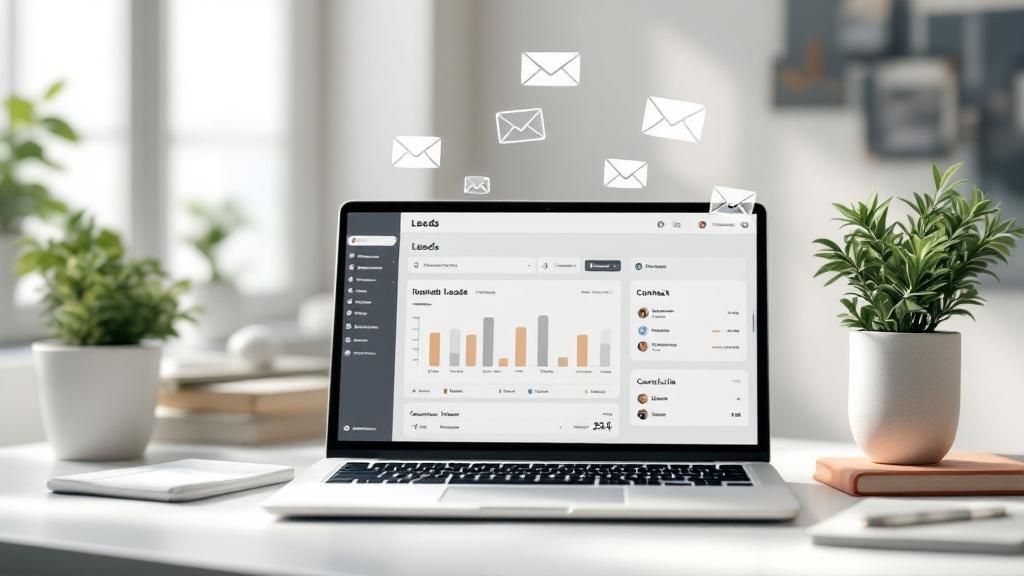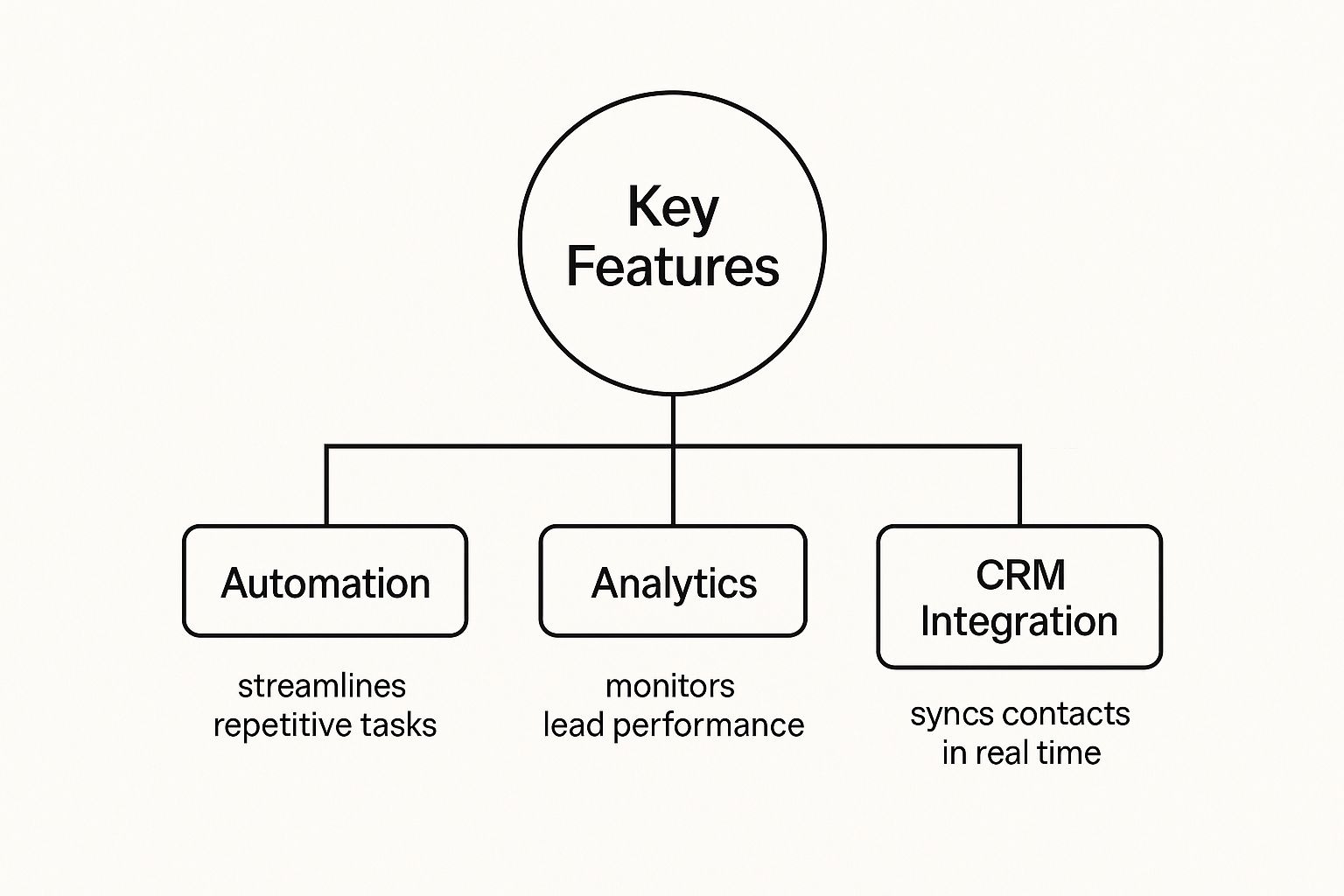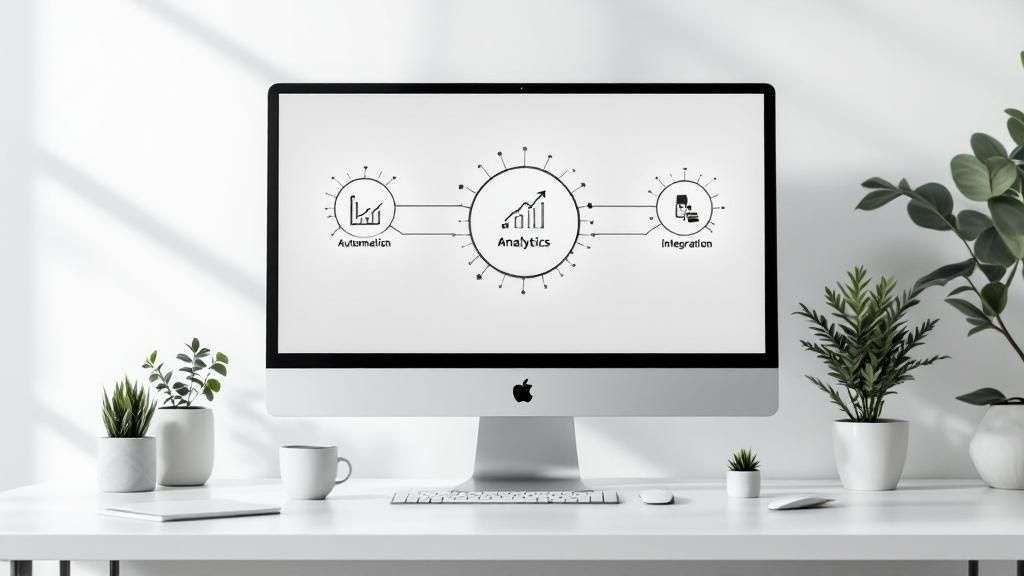Let's be honest, trying to find new business customers can feel like casting a huge, empty net into the ocean and just hoping you catch something. B2B lead generation software is what turns that empty net into a high-tech fishing fleet, equipped with sonar to find exactly where the best fish are schooling.
In simple terms, these tools are designed to automate the grunt work of finding, attracting, and qualifying potential business clients. They're the engine in your sales funnel, handling the repetitive tasks so your team can do what they do best: build relationships and close deals.
What Is B2B Lead Generation Software

Think of this software as the smarts behind your entire lead generation process. Its main job is to identify and engage potential customers long before a salesperson ever gets involved.
It handles all that heavy lifting at the beginning of the sales cycle, like capturing contact info from your website or figuring out which prospects are just browsing versus those who are actually interested. By automating these first steps, it keeps a steady stream of good leads flowing into your pipeline, which frees up your sales team for more meaningful conversations.
Why Every B2B Company Is Talking About This
As more business interactions move online, doing all this manually just doesn't cut it anymore. Companies are ditching old-school prospecting for technology that brings both efficiency and laser-focused precision.
The market growth tells the whole story. The global B2B lead generation software market is expected to rocket from $3.2 billion in 2023 to $9.8 billion by 2032. That's not just a trend; it's a fundamental shift in how businesses find new customers. You can dig into more of the data behind this surge over at dataintelo.com.
To really get what this software does, it helps to understand what it is and what it isn't. It’s a powerful system that fuels modern sales, but it's not a magic button that closes deals for you.
To make this distinction crystal clear, let's look at it side-by-side.
B2B Lead Generation Software At a Glance
| What It Is (A Smart Fishing Fleet) | What It Is Not (A Magic Sales Button) |
|---|---|
| A system to identify and attract potential customers who fit your ideal profile. | A tool that closes deals on its own. It needs a skilled salesperson to finish the job. |
| An automation engine for repetitive top-of-funnel tasks like data capture and initial follow-ups. | A replacement for your sales team. It's designed to make them more effective, not obsolete. |
| A lead qualification tool that scores and prioritizes prospects based on their interest and behavior. | A simple contact database. It's about finding quality and intent, not just collecting names. |
| A pipeline builder that ensures a consistent flow of warmed-up leads for sales to engage. | A "set it and forget it" solution. It requires strategy, setup, and ongoing optimization to work well. |
This table gets to the heart of a common misunderstanding. These tools don't take the human element out of sales; they amplify it.
A common misconception is that this software replaces salespeople. In reality, it empowers them. It acts as a tireless assistant, sorting through thousands of potential contacts to find the handful that are ready for a human conversation.
A Clear Distinction
So, what does this software actually do day-to-day? Its main purpose is to build and organize a list of qualified contacts who've shown some level of interest. This usually involves tasks like:
- Identifying Website Visitors: Pinpointing which companies are browsing your site, even if they don't fill out a form.
- Capturing Contact Details: Using smart forms, pop-ups, and chatbots to collect email addresses and phone numbers.
- Scoring Leads: Automatically ranking prospects based on their actions (like visiting your pricing page) and their profile (like company size or industry).
- Nurturing Prospects: Sending automated but personalized emails to keep your brand top-of-mind.
By handling these crucial top-of-funnel activities, the software ensures that by the time a lead lands in a salesperson's inbox, it's already vetted and warmed up. This simple handoff dramatically boosts the odds of having a successful conversation.
Core Features That Fuel Your Sales Pipeline
To really get what makes B2B lead generation software tick, you have to look under the hood at its core parts. Don't think of it as one single tool. It's more like a sophisticated workshop where every instrument has a specific job in building out your sales pipeline. These features are designed to work together, bringing automation, organization, and focus to your outreach.
Let's break down the essential features that turn a random website visitor into a genuinely qualified sales opportunity. Each one tackles a critical problem, turning what can be a chaotic process into a predictable system for growth.
Automated Lead Capture
Think about your website for a second. It's your 24/7 storefront. But without the right tools, potential customers can walk in, browse around, and leave without you ever knowing they were there. Automated lead capture is your digital greeter—a friendly, hyper-efficient one who never takes a coffee break.
This feature uses things like intelligent forms, well-timed pop-ups, and interactive chatbots to engage visitors the moment they show interest. It’s the net that catches prospects, making sure no potential deal slips through the cracks just because someone couldn’t be bothered to hunt for your "Contact Us" page.
A lot of what makes B2B lead generation software work is its ability to turn your website into a conversion machine. To get the most out of it, it helps to understand the fundamentals of Unlocking Website Conversion Optimization.
Centralized Contact Management
Once you start pulling in leads, you’ll hit a new problem almost immediately: data chaos. Leads are coming in from all over the place—social media, your blog, webinars—each with different details. Trying to manage this in a spreadsheet is a recipe for disaster. This is where centralized contact management becomes your command center.
It pulls all your prospect data into a single, searchable database. But this isn't just a fancy address book. It's an enriched profile that keeps a running log of every single interaction a lead has with your company.
This feature turns a messy pile of names and emails into an organized library of opportunities. It gives your sales team the context they need for meaningful conversations, showing them who the lead is, where they came from, and what they actually care about.
This map shows how automation, analytics, and CRM integration are all interconnected pillars, holding up the whole lead generation process.

It’s a great visual reminder that success isn't about having one strong feature. It’s about how they all sync up to create a smooth flow of information and action from start to finish.
Intelligent Lead Scoring
Here's a hard truth: not all leads are created equal. Some are ready to pull out their credit card today, while others are just kicking the tires. A sales team that treats every lead the same will burn a massive amount of time chasing people who simply aren't ready to talk.
Intelligent lead scoring fixes this by acting as an automated filter. It assigns points to each lead based on who they are and what they do.
- Demographic Scoring: Points are added based on their job title, company size, industry, or location. Basically, does this person look like your ideal customer?
- Behavioral Scoring: Points are added for actions they take, like visiting your pricing page, downloading a whitepaper, or opening your emails. These are buying signals.
A director at a target company who has visited your pricing page three times is going to have a much higher score than an intern who just downloaded one blog post. This system automatically pushes the hottest leads to the top of the list, so your sales team always knows who to call first.
Seamless CRM Integration
Your lead generation software and your Customer Relationship Management (CRM) platform shouldn't be two separate islands. If they aren't talking to each other, valuable data gets stranded, leading to manual data entry, delays, and flat-out missed opportunities.
Seamless CRM integration is the bridge that connects them. It automatically syncs all the lead data, scores, and activity history straight into your CRM. The moment a lead hits a certain score, the software can create a new contact and assign it to the right salesperson, with all the context attached.
This real-time connection makes the handoff from marketing to sales completely smooth. It kills manual data entry and makes sure salespeople have the full story on every single prospect they contact. That alignment is what turns leads into customers.
The Real-World Benefits for Your Business

Putting new software into place can sometimes feel like a roll of the dice. But the right B2B lead generation software isn't just another item in your tech stack—it's a direct investment in predictable growth. Let’s get past the buzzwords and look at the tangible results that solve genuine business problems and put you on the fast track to more revenue.
The first thing you'll notice is a major jump in both the sheer number and the quality of your leads. By putting the top of your sales funnel on autopilot, these platforms are working 24/7 to catch prospects you’d otherwise miss, turning simple website traffic into a reliable flow of potential customers.
This automation is the perfect answer to the all-too-common frustration of a pipeline that’s either empty or completely unpredictable. Your team gets a steady stream of qualified opportunities without having to grind through manual prospecting.
Maximize Your Marketing ROI
Every single dollar in your marketing budget has to pull its weight. B2B lead generation software makes sure it does by letting you get incredibly precise with your targeting, which means you stop wasting ad spend on audiences that were never going to convert anyway.
Picture this: you're marketing a highly specialized piece of industrial equipment. Instead of casting a wide, expensive net, the software helps you pinpoint and connect with decision-makers at the exact companies that match your ideal customer profile. That focused approach gives you a much healthier return on your investment because your message is only hitting the right people.
By focusing resources on high-potential accounts, businesses can significantly reduce their customer acquisition costs. It's the difference between shouting into a crowd and having a direct, meaningful conversation with the right person.
This precision gets a serious boost from solid analytics features. You start getting deep insights into which channels, messages, and campaigns are actually moving the needle, allowing you to double down on what’s working and ditch what isn’t.
Empower Sales with High-Quality Leads
One of the oldest tug-of-wars in any company is the one between sales and marketing. Marketing pushes over a big list of leads, but sales argues they’re low-quality, leading to wasted time and missed quotas. A proper lead generation system changes the game entirely.
Features like lead scoring automatically rank prospects based on their online behavior and demographic info. By the time a lead lands in a salesperson's queue, it’s already been vetted and has shown clear signs of buying intent. Our complete guide on B2B sales lead generation dives deeper into how this alignment makes sales teams dramatically more efficient.
This solves two huge problems at once:
- Sales Focus: Your sales team can finally spend their time talking to engaged, interested prospects instead of chasing down cold contacts.
- Improved Morale: When salespeople are handed leads that actually turn into customers, their success rates and motivation go through the roof.
Fuel Strategic Decisions with Data
Gut feelings are no way to build a growth strategy. The best B2B lead generation software acts as your company's intelligence hub, collecting priceless data on every prospect interaction. This information is an absolute goldmine for making smarter business decisions.
The explosive growth in this market shows just how essential these platforms have become. The B2B lead generation software market was valued at USD 5.2 billion and is on track to hit USD 11.3 billion by 2033—a clear sign of its importance to businesses of all sizes. You can check out more detailed market growth projections to see where the industry is headed.
At the end of the day, these tools give you the clarity you need to scale with confidence. When you truly understand your customer journey and campaign performance, you can build a repeatable, data-driven engine for sustainable growth.
How AI Is Changing the Lead Generation Game
Artificial Intelligence isn't some far-off concept from a sci-fi movie anymore. It’s the engine running under the hood of the best B2B lead generation software today. Think of it this way: old software was like a calculator—it followed instructions perfectly. AI-powered software is more like a seasoned financial analyst—it doesn't just follow instructions; it spots trends and predicts what's coming next.
This is a huge shift. Instead of just reacting to what a lead does, modern tools are becoming proactive. They can sift through mountains of data to find patterns a human team could never hope to spot, completely changing how we find and connect with our next best customers.
The Power to Predict and Get Personal
The real magic of AI in lead generation is its ability to see into the future, so to speak. Traditional lead scoring works off a fixed set of rules, like "if they visit the pricing page, add 10 points." But AI-driven predictive lead scoring is a whole different beast. It's dynamic. It actually learns from your past wins and losses to figure out the subtle traits of prospects who are most likely to buy.
This means your software can start prioritizing leads based not just on what they've done, but on what they're statistically likely to do. It’s like having a chess master on your team who can see several moves ahead, letting your sales reps engage the right person at the exact right moment.
This predictive muscle also fuels hyper-personalization on a scale we've never seen before. Generative AI can now write incredibly relevant outreach emails that reference a prospect’s latest company news, a new industry trend, or specific pain points they've mentioned online.
AI gives you the power to treat every prospect like they're your only prospect. By automating that deep, personal touch, it makes sure every interaction feels relevant and valuable, building trust from the very first email.
The Rise of Smarter Automation
Beyond just personalizing emails, AI is making automation a whole lot smarter. Take AI-powered chatbots, for example. They're no longer just glorified FAQs. These are tireless digital agents on your website, available 24/7.
They can hold natural conversations, qualify a visitor's needs in real-time, and even book meetings for high-intent leads directly on a salesperson's calendar. This kind of intelligent automation means you never miss an opportunity, whether it comes in at 2 PM or 2 AM.
And the results speak for themselves. Recent research shows 85% of B2B marketers expected AI to have a positive impact on their work. More specifically, AI chatbots have been a game-changer, with 15% of marketers seeing a lead generation surge of over 30%. These tools aren't just for lead capture; they're also helping teams understand their audience and educate prospects along the way. You can dig into more stats about how AI is boosting B2B marketing results on passivesecrets.com.
Gaining an Edge Through Pure Efficiency
When you boil it all down, bringing AI into your lead generation process gives you a serious competitive advantage. By handing over the most tedious, time-sucking parts of prospecting and qualification to the machines, you free up your team to do what they do best: build relationships and close deals.
AI tools handle the heavy lifting—the data crunching, the pattern spotting, the initial outreach. This lets your people apply their expertise where it truly counts. It's this blend of human skill and machine intelligence that defines a modern, high-performing sales team. Companies leaning into this aren't just working harder; they're working smarter, faster, and with a level of precision that leaves the competition in the dust.
Choosing the Right Software for Your Business

Picking the right B2B lead generation software feels a lot like choosing a new car. You're not just looking at the shiny paint job; you need something reliable that fits your needs today, has room for you to grow, and won't sputter out when you're counting on it.
Get this wrong, and you're stuck with wasted budget, a frustrated team, and a tool that just gathers digital dust.
The biggest mistake? Getting distracted by flashy features you'll never actually use or, worse, picking a system so complicated your team avoids it. The best software isn't the one with the longest feature list. It’s the one that clicks perfectly with your goals, your team's workflow, and the tools you already use.
Having a clear game plan is your best defense against buyer's remorse. When you evaluate every option against the same set of practical criteria, you can cut through the marketing fluff and find a platform that actually helps you grow.
Evaluate Your Core Business Needs First
Before you even book a demo, take a step back and figure out what problem you're really trying to solve. Is your website leaking potential leads? Is your sales team burning hours on prospects who are just kicking tires? Or is the disconnect between sales and marketing your biggest bottleneck?
Pinpoint your primary objectives first. These goals will be your compass, guiding you to the features that actually matter.
- If you're focused on growth: You need a platform built for scale. Can it handle a flood of new leads without breaking a sweat?
- If you're a smaller business: Simplicity is king. An intuitive, straightforward tool means your team can get up and running fast, no lengthy training required.
- If you're an established company: It's all about integration. The software must play nice with your CRM and other mission-critical tools to keep everything running smoothly.
This simple self-assessment keeps you from buying a powerful tool that solves the wrong problem. It ensures your choice becomes a strategic asset, not just another line item on your credit card statement.
Key Criteria For Your Software Shortlist
Once you know what you need, you can start building your shortlist. Think of this as your pre-purchase inspection. Any serious contender should get high marks in these four critical areas.
1. Scalability and Future Growth
The business you run today isn't the one you'll be running in two years. Your software should be a partner in that growth, not a roadblock. Ask vendors how their platform handles more users, bigger contact lists, and increasingly complex campaigns. A scalable solution is one that grows with you.
2. Ease of Use and Team Adoption
What good is a high-octane engine if no one knows how to drive it? The most feature-packed software on the planet is worthless if your team finds it clunky and confusing. Look for a clean interface, logical navigation, and simple workflows. A platform's real value is directly tied to how easily your team adopts it.
If simplifying your workflow is a priority, our guide on how to automate lead generation offers some great insights that pair well with a user-friendly tool.
3. Integration Capabilities
Your lead gen software doesn't live on an island. It has to talk to your other systems, especially your CRM. A clunky, disjointed integration creates headaches—think manual data entry, lost context, and dropped balls.
A seamless connection between your lead software and CRM isn't a "nice-to-have," it's non-negotiable. It means marketing can qualify a lead and sales instantly gets the full story, creating a smooth handoff that keeps deals moving.
4. Quality of Customer Support
Sooner or later, something will go wrong. When it does, you need to know help is there. Check out a provider's support options. Is it just email tickets, or can you get a real person on the phone or via live chat? Fast, knowledgeable support can be the difference between a minor hiccup and a full-blown crisis.
To help you stay organized during your search, use this checklist to compare your options side-by-side.
Software Selection Checklist
| Evaluation Criteria | Key Questions to Ask | Importance (High/Medium/Low) |
|---|---|---|
| Business Needs Alignment | Does this software directly address our primary pain points (e.g., lead capture, qualification, nurturing)? | High |
| Ease of Use & Adoption | How intuitive is the user interface? What is the estimated training time for our team? | High |
| Integration Capabilities | Does it seamlessly integrate with our existing CRM, email marketing tools, and other key software? | High |
| Scalability | Can the platform handle our projected lead volume and user growth over the next 2-3 years? | High |
| Reporting & Analytics | Does it provide clear, actionable insights into campaign performance and ROI? | Medium |
| Customization | Can we tailor workflows, fields, and reports to match our specific sales process? | Medium |
| Customer Support | What support channels are available (phone, chat, email)? What are their typical response times? | High |
| Pricing & Value | Is the pricing model transparent? Does the total cost of ownership align with the value it provides? | High |
| Security & Compliance | Does the provider adhere to data privacy regulations like GDPR or CCPA? | Medium |
Using a structured approach like this ensures you look beyond the sales pitch and select a tool that truly aligns with your operational reality and long-term vision.
Getting Your New Tool to Actually Work for You
Buying a new piece of B2B lead generation software is just the start. The real magic happens when you weave it into the fabric of your daily sales and marketing grind. That's when you see the return on your investment, turning it from just another subscription into a real engine for growth.
Think of it this way: just handing over the login details and hoping for the best is a recipe for disaster. You need a plan. A proper rollout makes sure everyone understands why you bought this thing, not just how to click the buttons. It's like getting a fancy new piece of equipment—you need to follow the instructions to get it humming.
Building a Strong Foundation
First things first: your team has to be on board, and that means solid training. This isn't just a box-ticking exercise. Your goal is to create a few internal champions who feel genuinely confident using the platform.
Start with the features that solve their biggest headaches right now. Maybe that's automating lead capture from your website or setting up a simple welcome email sequence. Once they’ve nailed the basics and are seeing the benefits, you can introduce the more advanced stuff. It's a phased approach that stops people from feeling overwhelmed and builds momentum instead.
The most powerful software on the planet is useless if your team won't touch it. Success comes down to good training, clear processes, and showing people how this tool makes their jobs easier, not harder.
With the team feeling comfortable, it’s time to get under the hood and configure your lead management workflows. This is where your sales strategy becomes a series of automated, repeatable actions.
Firing Up Your Lead Nurturing Engine
Your first task is to define exactly what a "sales-qualified lead" (SQL) looks like for your business inside the software. This is your most important filter. It ensures your sales team isn't wasting time on tire-kickers and only talks to people with real buying intent. A simple lead scoring system based on who they are and what they do on your site is the perfect way to do this.
Next, start building out your first automated nurturing sequences. These aren't complicated. They’re just simple, multi-step email campaigns designed to keep your brand in front of new leads, educating them and building trust over time.
But remember, automation isn't a "set it and forget it" game. It requires a bit of finesse. For instance, you need to be aware of the common LinkedIn automation mistakes to avoid so your outreach feels personal and helpful, not robotic and spammy.
Here are a few initial workflows you should build right away:
- Welcome Sequence: Set up an automated series of emails that goes out to anyone who downloads an ebook or signs up for your newsletter. Use it to introduce your brand and offer more value.
- High-Intent Alerts: Create a rule that instantly pings a sales rep when a lead does something that signals they're hot, like visiting your pricing page three times in a week.
- Re-engagement Campaign: Build a simple workflow to automatically poke leads who have gone cold, trying to bring them back into the fold after a few months of silence.
Finally, make that analytics dashboard your new best friend. Check it regularly. Keep a close eye on key metrics like conversion rates from one stage to the next, how quickly leads move through your pipeline, and which campaigns are actually performing. This data is your roadmap for making things better, showing you exactly what’s working and what you need to tweak.
Got Questions? We've Got Answers
Stepping into the world of B2B lead generation software always kicks up a few questions. As you start looking at different platforms, you'll naturally wonder how a new tool will slot into your current workflow. Let's clear up some of the most common questions we hear all the time.
Think of these as the essential bits of info you need to understand the role this software plays, why it’s a game-changer for businesses of any size, and what to expect when you dive in.
How Does B2B Lead Generation Software Differ From a CRM?
Great question. Think of it like a fishing boat versus a fish market.
Lead generation software is the specialized boat you take out to find and catch new, high-quality prospects. It’s all about attraction and that initial qualification right at the top of the funnel.
A Customer Relationship Management (CRM) system, on the other hand, is the bustling market where you manage relationships with all the prospects and customers you’ve already brought ashore. It’s built for tracking deals, managing your sales pipeline, and nurturing long-term relationships. They’re both powerful on their own, but they work best together when the "boat" can seamlessly pass its best catches over to the "market."
Can a Small Business Benefit from This Software?
Absolutely. In fact, for a small business, automation is a secret weapon. This kind of software takes a massive amount of manual prospecting and soul-crushing data entry off your plate, freeing up your small team to focus on what actually moves the needle: building relationships and closing deals.
Many platforms offer flexible, scalable plans designed specifically for smaller teams. This gives you access to the same powerful tools that bigger companies use, letting you compete effectively without needing a massive budget to do it.
For a small business, this software isn't a luxury; it's a force multiplier. It automates the repetitive work that bogs down a lean team, allowing them to punch well above their weight in the market.
What Is the Typical Learning Curve?
It really depends on the platform, but most modern B2B lead generation software is built with real humans in mind. You should definitely plan for an initial setup period—maybe a few weeks—to get the tool fully integrated with your other systems and get the team comfortable.
The best way to tackle it is to start simple. Nail down the core features first, like setting up lead capture forms and basic email sequences. Once your team gets the hang of it, you can start rolling out the more advanced stuff, like detailed lead scoring and complex nurturing workflows. Taking it step-by-step prevents everyone from getting overwhelmed and makes sure the tool actually gets used.
Ready to stop prospecting by hand and start building a real pipeline? Salesloop.io gives you the tools to automate your outreach, connect with the right decision-makers, and finally make your sales process predictable. See how Salesloop.io can transform your lead generation today.





